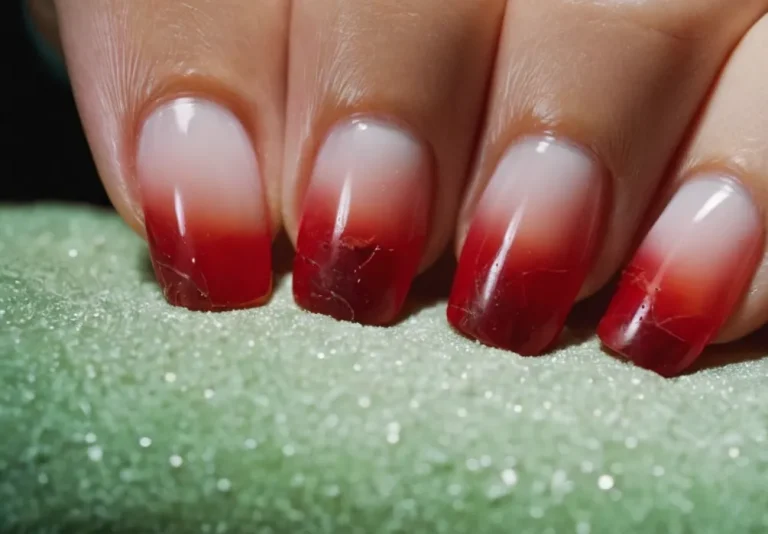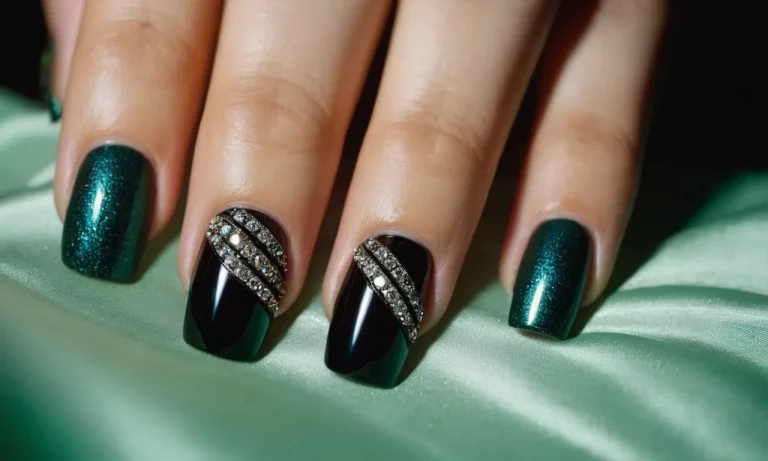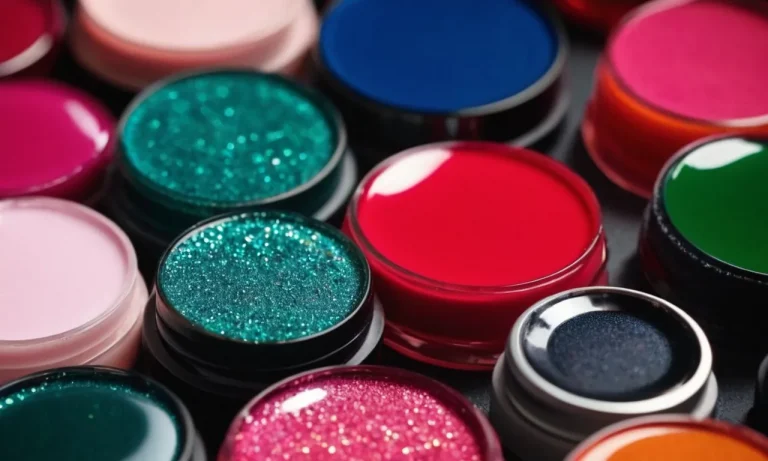How Long Does It Take For Nails To Grow Out? A Detailed Look
If you’ve just had a manicure or trimmed your nails shorter than you wanted, you’re probably wondering – how long will it take for my nails to grow back? Nail growth can seem painfully slow when you’re waiting for length. The good news is, nails do grow faster than you may realize.
If you’re short on time, here’s a quick answer to your question: On average, fingernails grow about 3 to 5 millimeters per month. Toenails are slower, growing about 1 to 2 millimeters per month. So if you trim your fingernails short, it will take 2 to 4 months to fully replace them.
What Impacts Nail Growth Speed?
Age
Fingernails grow faster in youth, reaching their peak growth rate in teenagers and young adults. As we age, nail growth slows down. In seniors over age 80, the growth rate can decline by 50% compared to teenagers (source).
The reason is likely tied to circulation, cell turnover rates, hormone levels, and overall health.
Health and Nutrition
Poor health, nutritional deficiencies, and medical conditions can negatively impact nail growth. For instance, thyroid disorders, diabetes, anemia, and eczema are associated with slower nail growth. Ensuring adequate intake of nutrients like vitamins, minerals, protein, zinc and iron allows for optimal nail cell production.
Pregnancy
During pregnancy, many women are astounded by how fast their nails can grow. Nail growth rates increase by as much as 30% during pregnancy. Higher estrogen levels and increased blood circulation to the extremities are likely contributors (source).
After childbirth, as hormones regulate, the nails return to normal growth patterns.
Season and Climate
External temperature and climate can influence nail expansion and growth cycles. In cold weather, nails tend to grow slower. The opposite occurs in summer’s warmth. This pattern aligns with how hair growth rates also fluctuate seasonally.
An underlying factor is likely blood circulation changes due to environmental temperatures.
Damaged Nails
Injury to nails, including breaks, tears, infections or fungal infections cause growth interruptions and deformities as the nail heals. Damaged nails may even cease growth for a period. As healing progresses, the nail plate cells must regenerate and reattach properly to regain normal expansion.
Topical medications, supplements or removal of damaged parts can help normalize growth.
Nail Shape and Type
| Nail Type | Average Growth Rate |
|---|---|
| Fingernails | 3-4 mm per month |
| Toenails | 1-2 mm per month |
Toenails grow significantly slower than fingernails, only about 50% the rate. Thicker nails, usually on the dominant hand, also expand slower due to added keratin volume. For most people though, consistent nail care helps optimize their growth potential regardless of thickness or hand/foot differences.
Average Nail Growth Rates
Fingernails
On average, fingernails grow at a rate of 3-4 millimeters per month. This translates to about 1/8 to 1/4 inch of new nail growth per month. Fingernails require 3-6 months to regrow completely after being cut.
There are several factors that influence fingernail growth rate:
- Age – fingernails grow fastest in youth and slow down as we age.
- Health and nutrition – poor health and nutrient deficiencies can slow nail growth.
- Pregnancy – increased growth is common during pregnancy.
- Seasons – some research shows nails grow faster in summer.
- Dominant hand – the dominant hand may grow nails slightly faster.
In ideal health conditions, the average rate can reach 1/2 inch per month. For someone in poor health or nutrient deficient, the rate may reduce to less than 1/4 inch monthly.
Toenails
On average, toenails grow at about 50% the rate of fingernails. The typical rate is 1-2 millimeters per month, or 1/16 to 1/8 inch.
It takes 12-18 months for toenails to regrow fully after being cut. The slower rate is believed to result from reduced blood circulation to the feet versus the hands.
As with fingernails, age, health, and nutrient status can impact growth speed. Injuries, fungal infections, and nail disorders also slow toenail growth.
Optimal conditions can result in growth exceeding 1/4 inch per month. Poor health may reduce monthly growth to less than 1/16 inch.
Tips for Healthy, Fast-Growing Nails
Moisturize Nails and Cuticles
Keeping nails and cuticles moisturized is key for healthy, fast growing nails. The cuticles act as a seal to prevent infection, so keeping them hydrated prevents hangnails and infections that can slow growth. Apply a hydrating cuticle oil or cream daily, gently massaging into nails and cuticles.
Products with ingredients like vitamin E, jojoba oil, and shea butter work best. Moisturized nails resist chipping and breakage that hinder growth.
Trim Nails Properly
Improper nail trimming can damage nails, slowing growth. Use sharp nail clippers or scissors designed for trimming nails. Trim nails straight across to avoid painful ingrown nails. File nails gently in one direction to smooth edges. Avoid aggressive filing that thins nails.
Trimming nails every 1-2 weeks encourages healthy growth so nails don’t snag and tear.
Avoid Harsh Chemicals on Nails
Frequent use of nail polish remover and acrylic nails leach keratin and cause dry, brittle nails. This leads to slowed growth and increased breakage. If using polish, choose acetone-free remover and give nails an occasional break from polish.
Avoid excessive use of acrylic nails and soaks in harsh chemicals like bleach. Wear gloves during cleaning and chemical exposure.
Take Vitamins and Nutrients
Just like hair, taking vitamins helps nails grow. Biotin supplements are best known for fast growing nails. Aim for 2.5 mg of biotin daily. Other key nutrients include vitamins A, C, D, E, iron, calcium, magnesium, and zinc. Eat foods rich in these or take supplements.
A balanced, nutritious diet also provides protein for keratin production.
Let Nails Breathe
To thrive, nails need periods of exposure to air. Polish acts as a barrier preventing nails from getting oxygen. Take a break between polishes, leaving bare for a few days. Since moisture is also key, use a hydrating cream for naked nails. Alternate polish with breaks for healthy nails.
Consider Nail Treatments and Enhancements
Occasional use of nail hardeners helps strengthen nails. Look for products with proteins and calcium to nourish nails. Limit use to avoid brittleness. Nail enhancements like dips, gels, or acrylics protect natural nails if not overused. They allow nails to grow underneath while getting stronger.
Have a professional remove enhancements to avoid nail damage.
When to See a Doctor about Slow or Abnormal Nail Growth
Nail growth problems like unusually slow growth or abnormal shape/texture can sometimes indicate an underlying health issue. While mild changes are harmless, it’s important to see a dermatologist in certain cases – especially if you notice changes in several nails or if it impacts your daily life.
Some reasons to get checked out include:
Fungal Infections
Fungal infections are a common cause of abnormal nails. According to the American Academy of Dermatology Association (AAD), up to 8% of adults in North America have toenail fungus. Signs include thickened, discolored nails with debris under them. Fingernails can also be affected.
While OTC antifungals can help mild cases, prescription meds are needed for moderate to severe infections. Getting treatment quickly improves success.
Skin Conditions
Certain skin conditions are linked to nail abnormalities. For instance, psoriasis can cause pitting, ridges, and discoloration in the nails. Around 50% of people with psoriasis develop psoriatic nail changes (AAD). Nail issues can also result from eczema, lichen planus, and other skin diseases.
Seeing a dermatologist can help diagnose and treat the underlying problem.
Nutrient Deficiencies
Lack of key nutrients can affect nail growth and health. For example, iron deficiency has been associated with koilonychia or spoon nails – where nails curve inward. Biotin deficiency can also cause brittle, thinning nails (NCBI).
If dietary changes don’t help, talk to your doctor about getting lab testing done to check for vitamin/mineral deficiencies.
Medications
Certain medications may cause nail changes as a side effect. According to an NIH study, drugs that can negatively impact nails include retinoids, beta blockers, chemotherapy agents, and some antibiotics.
Determining if a medication is the culprit allows a doctor to consider alternatives with fewer nail-related effects.
In most cases, slow nail growth is nothing to worry about. But if you notice significant or progressive changes to multiple nails, it’s wise to make an appointment. Early treatment of underlying conditions can help restore proper nail growth and appearance.
With your doctor’s help, you can get your nails looking healthy again.
Conclusion
While it can be frustrating waiting for nails to grow out after a mishap or trim, remember that slow and steady wins the race. With proper care, nutrition and avoiding damage, you can maximize nail growth.
Most healthy individuals can expect nails to fully regenerate in 2 to 5 months for fingernails and 4 to 6 months for toenails. Be patient, take steps to encourage healthy growth, and your nails will be long again before you know it!







